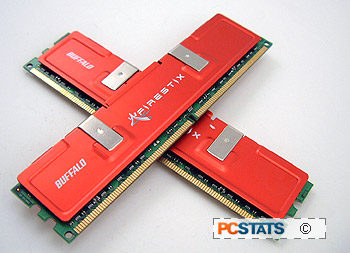 |
| Overclocking Results: |
|
|
It's always interesting to see how memory will
run with tight CAS latency, and with DDR2, you never know what you're going
to get.
The tightest timings the Buffalo
Technology FireStix FSX1000D2C-K2G will run at was 3-4-4-10, which actually isn't
bad for DDR2 memory. Starting at DDR2-800 speeds, the memory was overclocked in 5
MHz intervals.
At 875 MHz, the FireStix FSX1000D2C-K2G memory started to show some signs of instability, and
the memory voltage was increased from 1.8V to 2.0V to resolve minor stability
issues. Continuing upwards, the memory shortly hit the wall at 925 MHz,
anything higher and the system had issues booting into WindowsXP.
 Next up, we'll try
loosening the memory timings to the default setting; 5-5-5.
The FireStix FSX1000D2C-K2G frequency was overclocked from 925
MHz in 5 MHz intervals once again. This time around,
overclocking the Buffalo FireStix FSX1000D2C-K2G was quite uneventful until the test system hit
the dreaded 1020 MHz barrier.... that speed is like the monolith
in 2001.Anyway, our attempts to try speeds above 1020MHz generated some system instability, and so
we kept things at 1020MHz for the benchmarks.
Next up, we'll try
loosening the memory timings to the default setting; 5-5-5.
The FireStix FSX1000D2C-K2G frequency was overclocked from 925
MHz in 5 MHz intervals once again. This time around,
overclocking the Buffalo FireStix FSX1000D2C-K2G was quite uneventful until the test system hit
the dreaded 1020 MHz barrier.... that speed is like the monolith
in 2001.Anyway, our attempts to try speeds above 1020MHz generated some system instability, and so
we kept things at 1020MHz for the benchmarks.
It's most likely the processor is holding back the
memory as the Intel Pentium D 840 would be overclocked to 4.08 GHz. With a better overclocking
processor I'd expect the Buffalo FSX1000D2C-K2G to reach much higher - but since
we haven't tested that for certain, it's just an assumption.
Prelude to
Benchmarks
The details of how the Buffalo
Technology FSX1000D2C-K2G memory test system was configured for
benchmarking, including the specific hardware, software drivers, operating
system and benchmark versions are indicated below. In the second column are the
general specs for the reference platforms this pair of DDR-2 memory is to be
compared against. Please take a moment to look over PCSTATS test system
configurations before moving on to the individual benchmark results.
 |
| PCSTATS Test System Configurations |
|
|
 Office
Productivity Office
Productivity |
Source: Zdnet |
|
Business
Winstone 2004 runs real applications through a series of scripted activities and
uses the time a PC takes to complete these activities to produce its performance
scores.
Content
Creation Winstone 2004 is a system-level, application-based benchmark that
measures a PC's overall performance when running top, Windows-based, 32-bit,
content creation applications in Windows XP.
| Office
Productivity |
| Business Winstone 2004: |
Points |
Ranking |
| 2x 512MB Mushkin PC2-4200 (200/533) |
32.9 |
   |
| 2x 512MB Crucial Ballistix PC2-5300 (200/667) |
32.7 |
   |
| 2x 512MB Corsair PC2-8000UL (200/800) |
33.4 |
   |
| 2x 1024MB Corsair Twin2X2048-6400 PRO
(200/800) |
32.5 |
   |
| 2x 1024MB Super Talent T800UX2GC4 (200/800) |
33.8 |
   |
| 2x 1024MB Patriot PDC22G8000+XBLK (200/800) |
33.8 |
   |
| 2x 1024MB Buffalo FSX1000D2C-K2G (200/800) |
33.6 |
   |
| 2x 1024MB Buffalo FSX1000D2C-K2G (255/1020) |
35.7 |
   |
| Content Creation 2004: |
Points |
Ranking |
| 2x 512MB Mushkin PC2-4200 (200/533) |
25.1 |
   |
| 2x 512MB Crucial Ballistix PC2-5300 (200/667) |
25.7 |
   |
| 2x 512MB Corsair PC2-8000UL (200/800) |
26.1 |
   |
| 2x 1024MB Corsair Twin2X2048-6400 PRO
(200/800) |
26.3 |
   |
| 2x 1024MB Super Talent T800UX2GC4 (200/800) |
26.2 |
   |
| 2x 1024MB Patriot PDC22G8000+XBLK (200/800) |
26.2 |
   |
| 2x 1024MB Buffalo FSX1000D2C-K2G (200/800) |
26.3 |
   |
| 2x 1024MB Buffalo FSX1000D2C-K2G (255/1020) |
29.3 |
   |
At stock speeds the Buffalo Technology FSX1000D2C-K2G
memory performs as expected, the overclocked results scale nicely.
